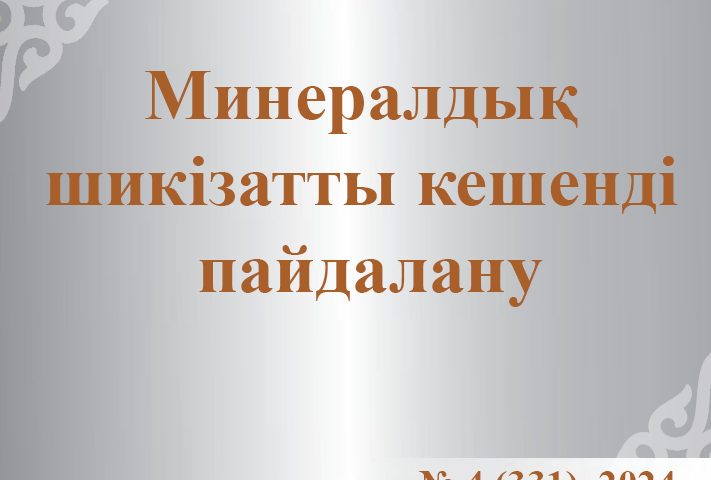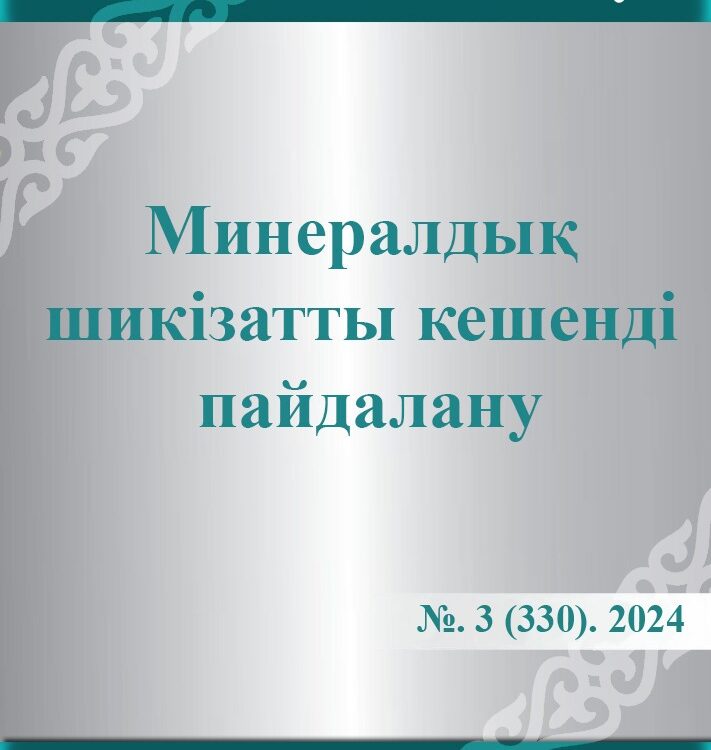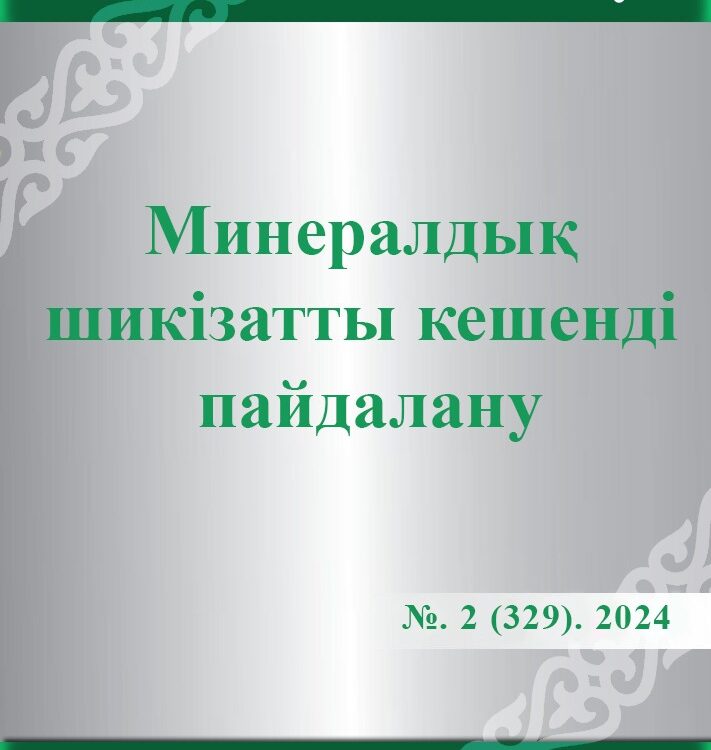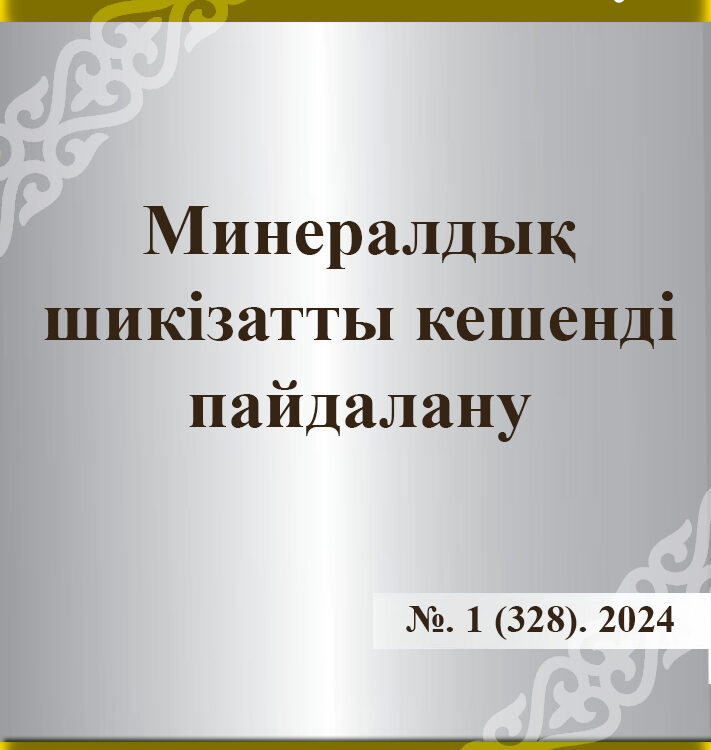Title: Study of the material composition of refractory gold-bearing ore from the Aktobe deposit
Authors: Barmenshinova M.B., Motovilov I.Y., Telkov Sh.A., Omar R.S.
Abstract: The study of the material composition of gold-bearing ores includes the determination of quantitative chemical and mineral composition, forms of noble metals, granulometric composition, and physical and mechanical properties to choose the direction for the development of an effective technology of their complex enrichment. This work is devoted to the study of the material composition of refractory gold-bearing ore of Aktobe deposit. It was determined that the content of gold is 1.55-1.6 g/t, the mass fraction of silver is 42-43 g/t, and the content of sulphur is low and is 1-1.1% respectively. Of non-ferrous metals, zinc 0.17%, and lead 0.15% are present in insignificant amounts, and the content of harmful impurities antimony and arsenic are insignificant and amounted to 0.01 and 0.05%. The ore sample has a relatively uncomplicated mineral composition: rock-forming minerals represented by quartz, potassium feldspar, calcite, and mica predominate significantly. Ore minerals are represented by pyrite up to 10 %, limonite up to 0.5 %, galena 0.15-0.2 %, sphalerite 0.17-0.2 % and gold. Physical and mechanical properties of the ore were determined. According to the category of crushability, the ore belongs to the category of medium hardness. According to Bond's method, the "index of network Wi" of ball milling was determined for the initial ore, which was 19.3 kW∙h/t∙μm0.5. Based on the obtained data on the study of material composition, further research will be directed to the study of gravity and flotation enrichment.
Keywords: gold, silver, chemical analysis, mineralogical analysis, granulometric analysis, physical and mechanical properties.
Cite this article as: Barmenshinova MB, Motovilov IYu, Telkov ShA, Omar RS. Study of the material composition of refractory gold-bearing ore from the Aktobe deposit. Kompleksnoe Ispolzovanie Mineralnogo Syra = Complex Use of Mineral Resources. 2024; 331(4):5-11. https://doi.org/10.31643/2024/6445.34
Title: Modified bitumen-polymer mastic to protect metal coatings from corrosion
Authors: Sabergaliyev M.M., Yeligbayeva G.Z, Khassanov D.A., Muradova S.R., Orazalin Z.K., Ainakulova D.T., Sharipov R.Kh., Negim El-Sayed
Abstract: The protection of metallic structures against corrosion remains a pivotal challenge across numerous industries. In recent years, the amalgamation of modified bitumen with epoxy resin has emerged as a promising avenue in the pursuit of enhanced corrosion protection. This novel composite material showcases exceptional potential in thwarting the deleterious effects of corrosion, offering an innovative solution to safeguard vital infrastructure, industrial components, and diverse metallic substrates. The synergistic properties stemming from the combination of modified bitumen and epoxy resin present an intriguing prospect for superior durability, chemical resistance, and structural integrity, thereby fostering advancements in the realm of anti-corrosion coatings. This scientific article endeavours to explore the efficacy, mechanisms, and potential applications of this composite material as an effective barrier against corrosion, shedding light on its transformative impact within corrosion mitigation strategies. In this study, bitumen was modified using epoxy resin ELM-NG900Z and hardener in a ratio of 1.0: 5: 1.5 respectively. The modified bitumen was further tested by mechanical tests and solvent tests. The samples of modified bitumen successfully passed the tests and showed results better than the reference(epoxy resin without bitumen).
Keywords: Bitumen-epoxy resin, Bitumen, epoxy, corrosion.
Cite this article as: Sabergaliyev MM, Yeligbayeva GZ, Khassanov DA, Muradova SR, Orazalin ZK, Ainakulova DT, Sharipov RKh, Negim El-Sayed. Modified bitumen-polymer mastic to protect metal coatings from corrosion. Kompleksnoe Ispolzovanie Mineralnogo Syra = Complex Use of Mineral Resources. 2024; 331(4):12-20. https://doi.org/10.31643/2024/6445.35
Title: Polyurethane as a versatile polymer for coating and anti-corrosion applications: A review
Authors: Yeligbayeva G., Khaldun M. A., Abdassalam A. Alfergani, Tleugaliyeva Zh., Karabayeva A., Bekbayeva L., Zhetpisbay D.S., Shadin N.A., Atabekova Z.
Abstract: The development of polyurethane materials and process optimization are currently the subjects of extensive study. Polyurethane is characterized by high physicochemical and operational properties. Polyurethanes have high wear resistance, and oil and gasoline resistance. They have excellent thermophysical and elastic properties. This allows the use of polyurethanes in many industries where materials with high-performance properties are required. Polyurethanes are widely used in many industrial applications, protective coating manufacturing, and anti-corrosion agent applications. A significant number of studies have been conducted to improve the physical, mechanical, and operational properties of polyurethane polymers, in particular the anti-corrosion properties of modified polyurethane coatings. The properties of polyurethane polymers for various applications can be improved by changing monomers and their ratios and the process of preparations. Preparation of polyurethane polymers based on polyols and isocyanate monomers using a polyaddition process in the presence of a catalyst as well as solvents including toluene, xylene, and acetone. There are different factors affecting the physical and mechanical properties of polyurethane polymers were investigated by different techniques. The factors were types of isocyanates, polyols, OCN/OH ratios, solvents, catalysts, and temperatures. Generally, the polyols are responsible for the flexibility of the polyurethane polymers and isocyanates are responsible for the rigidity of the polyurethane polymer and crosslinking between the backbone of the polymer. Because of the flexibility of its chemistry, they may modify the coating's characteristics based on the intended use. The effects of different polyols and polyisocyanates' chemistry are assessed. The hydrophobicity, thermal stability, and mechanical and anti-corrosion properties of polyurethane polymers were investigated. As a result, the properties of polyurethane polymers such as hydrophobicity, thermal stability, and mechanical and anti-corrosion properties were all enhanced when all the above factors. An outline of the most modern, financially successful methods for creating protective polyurethane coatings and using them as anti-corrosion agents is given in this review article.
Keywords: Polyurethane, coating, anti-corrosion, polyols, polyisocyanates.
Cite this article as: Yeligbayeva G, Khaldun MA, Abdassalam A Alfergani, Tleugaliyeva Zh, Karabayeva A, Bekbayeva L, Zhetpisbay DS, Shadin N.A., Atabekova Z. Polyurethane as a versatile polymer for coating and anti-corrosion applications: A review. Kompleksnoe Ispolzovanie Mineralnogo Syra = Complex Use of Mineral Resources. 2024; 331(4):21-41. https://doi.org/10.31643/2024/6445.36
Title: Geochemistry of Rare Earth Elements in Pahang River Sediment, Malaysia
Authors: Chang S.C., Yusoff A.H., Mohamed C.A.R., Liu S.F., Shoparwe N.F., Husain N.A, Azlan M.N.
Abstract: Rare earth elements (REE) are a set of 17 chemically similar metallic elements including 15 lanthanides, scandium and yttrium. The current status of REE as a global strategic commodity has encouraged the identification of REE ore deposits. This research is carried out to identify the mining feasibility of fluvial sediment REE and to understand the sediment's physical and chemical characteristics and effects on the geochemical behaviour of REE in the longest river of Peninsular Malaysia namely Pahang River. Surface sediment samples were collected along Pahang River (n=44) in approximately 10 km distance intervals. The sediment samples were analyzed using XRF to determine the major oxide content. Meanwhile, REE content in the sediment samples was extracted using the Total Digestion method and analysed using ICP-MS. The results show the average value of ΣREE at surface sediments of the Pahang River is 42.58 ppm and can be considered too low to be economically mined. Each area shows higher fractionation of light REE than heavy REE with negative europium anomalies, suggesting sediments in this area were derived from felsic rocks. The concentration of REE in Pahang River surface sediments was controlled by the porosity and organic matter as showed by the correlation of ΣREE with porosity (R2=0.65) and organic matter content (R2=0.71). In conclusion, this research's findings are generally useful for further REE mineral exploration and fluvial sediment environmental monitoring.
Keywords: XRD analysis; Rare Earth Elements; Pahang River, Organic Matter
Cite this article as: Chang SC, Yusoff AH, Mohamed CAR, Liu SF, Shoparwe NF, Husain NA, Azlan MN. Geochemistry of Rare Earth Elements in Pahang River Sediment, Malaysia. Kompleksnoe Ispolzovanie Mineralnogo Syra = Complex Use of Mineral Resources. 2024; 331(4):42-50. https://doi.org/10.31643/2024/6445.37
Title: Analyzing geodetic leveling and subsidence of benchmarks: data and conclusions for Zhezkazgan and GEV-Lermontovo villages
Authors: Zhunussova G.E., Igemberlina M.B., Abekov U.E.
Abstract: This article analyzes geodetic leveling data at sites in the villages of Zhezkazgan and GEV-Lermontovo for the period from 2014 to 2020 using correlation matrices, statistical tests, and box plots. Using the rock displacement data on benchmarks along selected profile lines, detailed analyses were conducted in two groups (Group "A" with the data from 2018 to 2020 and Group "B" with the in-depth study of subsidence levels since 2014). In group "A", correlation matrices were analyzed and statistically significant relationships were determined between the levels of subsidence of the benchmarks. Group "B" was aimed at studying changes in the level of subsidence along the three profile lines for different periods. Using box plots, the distribution and variability of subsidence levels were visualized, anomalies were identified and potential problem areas were identified. The results indicate significant subsidence on profile line 115 caused by mining activities in the area of the Lermontovo hydraulic fracturing site. These studies are valuable information for geodesists and geologists and can be used to manage urban development, infrastructure stability, and environmental protection in the region. The results obtained are of interest for further studies and can serve as the basis for the development of appropriate strategies and remedial measures.
Keywords: instrumental observations, geodetic monitoring, geodesy, leveling, profile lines
Cite this article as: Zhunussova GE, Igemberlina MB, Abekov UE. Analyzing geodetic leveling and subsidence of benchmarks: data and conclusions for Zhezkazgan and GEV-Lermontovo villages. Kompleksnoe Ispolzovanie Mineralnogo Syra = Complex Use of Mineral Resources. 2024; 331(4):51-59. https://doi.org/10.31643/2024/6445.38
Title: Depletion of converter slags to waste in the Vanyukov furnace during pyrometallurgical copper production at JSC Almalyk MMC
Authors: Yakubov M.M., Yoqubov M.M., Kholikulov D.B., Maksudhodjaeva M.S.
Abstract: The article shows the possibility of involving man-made formations in the pyrometallurgical production of copper in the form of slag and clinker-zinc production for the purpose of comprehensive extraction of non-ferrous and precious metals from them at Almalyk MMC JSC. Clinker, a technogenic waste from zinc production, contains a significant amount of reducing elements in the form of metallic iron and carbon, as well as gold in the amount of 2.3 g/t and silver 250 g/t. In research, clinker works as a reducer of magnetite contained in the converter slag during its depletion and in the process of depletion (reduction) of the converter slag, noble metals are extracted into matte, and then into blister copper up to 95-98%. Converter slags from copper production of Almalyk MMC JSC contain 2.0-3.5% copper, and they, as a circulating product, are depleted in a reverberatory furnace with copper extraction of 75%. To increase the yield of copper from converter slag in Vanyukov furnaces, it is necessary to first deplete the converter slag in reduction processes and then transfer it for processing. It was found that using clinker, a technogenic waste from zinc production with a particle size of +5 - -10 mm, the recovery of converter slag in a converter from magnetite to wustite using the developed technology in 10-15 minutes exceeded more than 50.0% (the amount of magnetite decreased from 21.9 % to 9.8%). As a result of processing recovered converter slags in the Vanyukov furnace, it was possible to reduce the copper content in converter slags of copper production from 2.2-3.5% to 0.58-0.72% in waste slag. To increase the yield of copper from converter slag in the reverberatory and Vanyukov furnaces, it is necessary to first deplete the converter slag in reduction processes and then transfer it for processing.
Keywords: copper, slag, converter slag, depletion, magnetite, extraction, clinker, concentrate.
Cite this article as: Yakubov MM, Yoqubov MM, Kholikulov DB, Maksudhodjaeva MS. Depletion of converter slags to waste in the Vanyukov furnace during pyrometallurgical copper production at JSC Almalyk MMC. Kompleksnoe Ispolzovanie Mineralnogo Syra = Complex Use of Mineral Resources. 2024; 331(4):60-68. https://doi.org/10.31643/2024/6445.39
Title: Prospects of oil and gas potential of the South Torgai sedimentary basin
Authors: Uakhiova A.A., Madisheva R.K., Askarova N.S., Adilkhanov R.K., Zheksenbaeva G.M.
Abstract: One of the main directions for assessing the prospects of oil production is the study of oils. In this regard, modern geochemical studies are widely used in forecasting the oil and gas potential of the subsurface, occupying an important role in the question of the origin and source of hydrocarbons. The study is aimed at a comprehensive analysis of the geochemical characteristics of the South Torgai sedimentary basin in order to identify and assess the prospects for oil and gas potential. Comparing the composition of oils from different deposits makes it possible to determine the oil source strata, zones of oil formation and oil accumulation. The compounds in oils that are most or least susceptible to changes under the influence of factors such as water leaching, biodegradation and thermal transformation are subject to comparison. The relative content of individual classes of compounds in the oils of the Aryskum trough, the geological characteristics of oil samples and the distribution of normal alkanes are presented. In this work, a comparative analysis of previously conducted geochemical studies was carried out to determine the composition and genesis of oils in the Aryskum trough. Biomarkers in oils, which make it possible to restore the genetic properties of oils and determine the conditions of sedimentation of oil-generating organic substances, indicate the presence of suboxidation conditions, redox potential and predominantly oxidative environment in the process of sedimentation of organic substances. The results obtained are important for understanding the processes of oil formation and generation, as well as for further forecasting the oil content of the South Torgai sedimentary basin.
Keywords: oil and gas content, organic matter, oil, biomarker analysis, graben-syncline, gorst-syncline.
Cite this article as: Uakhiova AA, Madisheva RK, Askarova NS, Adilkhanov RK, Zheksenbaeva GM. Prospects of oil and gas potential of the South Torgai sedimentary basin. Kompleksnoe Ispolzovanie Mineralnogo Syra = Complex Use of Mineral Resources. 2024; 331(4):69-78. https://doi.org/10.31643/2024/6445.40
Title: Calculation of the thermoplastic beryllium oxide slurry molding with ultrasonic activation
Authors: Zhapbasbayev U.K., Ramazanova G.I., Terekhov V.I., Sattinova Z.К.
Abstract: The article presents the results of assessing thermal shrinkage during the formation of beryllium oxide ceramics using the hot casting method. The thermoplastic slurry is a composite system with a dispersion medium (binder) that has a very low thermal conductivity compared to the dispersed phase (beryllium oxide). Ultrasonic treatment reduces the viscosity of the slurry and improves its casting properties. The formation of beryllium oxide slurry is carried out without disrupting the integrity of the system and depends on the casting speed and temperature factors. The combined influence of these factors determines the casting properties of the slurry. Cooling - solidification of the slurry in the casting mold occurs in stages in the liquid, amorphous states with a phase transition, and in the viscoplastic state of the casting. The cooling rate of the casting at all stages depends on the cavity design, the rheological properties of the slurry, and the casting process parameters. It is important to maintain the integrity of the casting due to temperature shrinkage.
Keywords: thermoplastic slurry, formation, shrinkage, casting properties, beryllium oxide, ultrasonic treatment.
Cite this article as: Zhabasbayev UK, Ramazanova GI, Terekhov VI, Sattinova ZК. Calculation of the thermoplastic beryllium oxide slurry molding with ultrasonic activation. Kompleksnoe Ispolzovanie Mineralnogo Syra = Complex Use of Mineral Resources. 2024; 331(4):79-89. https://doi.org/10.31643/2024/6445.41
Title: Recycling of beryllium, manganese, and zirconium from secondary alloys by magnesium distillation in vacuum
Authors: Volodin V.N., Аbdulvaliyev R.A., Trebukhov S.A., Nitsenko A.V., Linnik X.A.
Abstract: One of the methods for processing secondary magnesium raw materials containing rare refractory metals can be a distillation with the extraction of magnesium into condensate and the accumulation of rare metals in the distillation residue. The residue can be used as a master alloy for special alloys. To justify the possibility of this process, we calculated the boundaries of the vapor-liquid equilibrium fields for the regions of liquid solutions existence in the Mg – Be, Mg – Mn, and Mg – Zr systems at atmospheric pressure (101.33 kPa) and in vacuum (1.33 kPa). The value of the vacuum is due to the fact that a further increase in rarefaction will lead to the magnesium crystallization from the melt, and it will complicate the technology.We established that in the distillation process of magnesium removal from Mg – Be and Mg – Zr alloys, the vapor phase will be represented by more than 99.95 of magnesium. The presence of 0.45 mass.% Mn is possible in the Mg – Mn system at 1000 °C in thevapor phase – condensate . However, results of preliminary tests of the evaporation intensity established that the process conducted at 850-900 °C provides an acceptable evaporation rate of the volatile component (Mg) for technological conditions.Thus, we confirmed the possibility of the proposed method to process secondary light alloys containing beryllium, manganese, and zirconium, which can be involved in the main process intended to produce special alloys in the form of a master alloy with magnesium.
Keywords: magnesium, beryllium, manganese, zirconium, phase diagram, vapor-liquid equilibrium.
Cite this article as: Volodin VN, Аbdulvaliyev RA, Trebukhov SA, Nitsenko AV, Linnik XA. Recycling of beryllium, manganese,and zirconium from secondary alloys by magnesium distillation in vacuum. Kompleksnoe Ispolzovanie Mineralnogo Syra = Complex Use of Mineral Resources. 2024; 331(4):90-100. https://doi.org/10.31643/2024/6445.42
Title: Research on the possibility of obtaining medium-carbon ferromanganese from the Djezdinskoe deposit
Authors: Makhambetov Ye.N., Abdirashit A.M., Myngzhassar Ye.A., Burumbayev A.G., Zhakan A.M., Yucel Onuralp
Abstract: In this article, the results of laboratory studies on the smelting of medium-carbon ferromanganese using Djezdinskoe ores are presented. Kazakhstan has significant reserves of manganese ores represented by iron-manganese and carbonate-oxide ores. The manganese ores of the Djezdinskoe deposit are characterized by a relatively high manganese content (48%) and low iron content (2-5%). Sieve analysis was used to study the particle size distribution of the ore. Based on the results of the sieve analysis of ore samples obtained after sieving, a high manganese content (53.54%), low iron content (0.47%), and silicon dioxide content (2.25%) were identified. Laboratory experiments were conducted on smelting medium-carbon ferromanganese in the high-temperature Tamman furnace. According to the results of the laboratory experiments, it is recommended to use the size classes of -5.0 + 0.0 mm to obtain high-quality low-phosphorus silicon-manganese alloy and the size class of +5.0 to produce medium-carbon ferromanganese. The average chemical composition of the metal and slag is as follows: % Mn – 86 – 88; Si – 0.04 – 0.35; Fe – 1.78 – 2.0; P – 0.06 – 0.09; C – 1.5 – 2.0; MnO – 19-20; SiO2 – 13.94-14.5; CaO – 23.35 – 24.85; MgO – 13.25-14.0. Thus, an optimal technological scheme has been developed for the production of a wide range of manganese ferroalloys.
Keywords: Manganese ore, medium-carbon ferromanganese, low-phosphorus refined silicomanganese, differential thermal analysis, high-temperature furnace, ferroalloy.
Cite this article as: Makhambetov YeN, Abdirashit AM, Myngzhassar YeA, Burumbayev AG, Zhakan AM, YucelO. Research on the possibility of obtaining medium-carbon ferromanganese from the Djezdinskoe deposit. Kompleksnoe Ispolzovanie Mineralnogo Syra = Complex Use of Mineral Resources. 2024; 331(4):101-108. https://doi.org/10.31643/2024/6445.43
Title: Overview of Technologies Used to Extract Scandium from Secondary Raw Materials
Authors: Orynbayev B.M., Baigenzhenov O.S., Turan M.D.
Abstract: The exceptional mechanical and chemical properties exhibited by scandium, characterized by its low density, high strength, and remarkable resistance to corrosion, have positioned it as a sought-after metal in diverse industrial applications. Consequently, a surge in market demand for scandium has been observed, highlighting its unique attributes compared to other metals. The Republic of Kazakhstan has identified potential sources of scandium in the waste generated by the titanium, uranium, and aluminum industries. By implementing efficient processing techniques for these production wastes, the country can effectively address the deficit of scandium while also mitigating man-made emissions, thus significantly improving the environmental landscape. This article aims to explore and evaluate contemporary methodologies that have been employed for the recovery of scandium from the aforementioned secondary sources. By examining and analyzing these techniques, we can gain insights into the most effective and sustainable approaches to harnessing scandium from waste materials in Kazakhstan. This research not only contributes to meeting market demands but also ensures the responsible utilization of scandium, benefiting not just the country's economy but also its environmental sustainability.
Keywords: titanium wastes, rare metals, scandium, rare earth elements, leaching, chlorination
Cite this article as: Orynbayev BM, Baigenzhenov OS, Turan MD. Overview of Technologies Used to Extract Scandium from Secondary Raw Materials. Kompleksnoe Ispolzovanie Mineralnogo Syra = Complex Use of Mineral Resources. 2024; 331(4):109-116. https://doi.org/10.31643/2024/6445.44
Title: Study of the leaching process for dust chamber sublimates followed by the extraction of niobium and zirconium into solution
Authors: Yessengaziyev A.M., Toishybek A.M., Mukangaliyeva A.O., Abdyldayev N.N., Yersaiynova A.A.
Abstract: The material composition of the sublimates from dust chambers in titanium chlorinators has been studied by chemical, X-ray and microprobe analysis methods. Studies of the phase composition of dust chamber sublimates have shown that the object consists of aqueous and anhydrous chloride phases to a greater extent. Two forms of niobium present, such as oxychloride and oxide niobium were found. The presence of zirconium in sublimates has a chloride and oxychloride nature. Experiments for the aqueous leaching of dust chamber sublimates were conducted to determine the optimal process conditions: S:L ratio = 1:8, leaching time = 1 hour, temperature = 25℃. Studies were conducted to choose an acidic reagent for cake leaching followed by the conversion of niobium and zirconium into a solution. A solution consisting of HF+H2SO4 was selected as an acidic reagent for cake leaching. Optimal conditions for the extraction of niobium and zirconium into solution were established, such as 25% [18M HF] +75% [7M H2SO4], S:L ratio = 1:3, temperature = 90 °C, duration of the leaching process = 120 minutes. Under these leaching conditions, the extraction of niobium, zirconium, and titanium into solution was 94.06%, 84.95% and 32.35%, respectively. The elemental and phase composition of the residue from acid leaching of cake were determined.
Keywords: niobium, dust chamber sublimates, leaching, acid, solution.
Cite this article as: Yessengaziyev AM, Toishybek AM, Mukangaliyeva AO, Abdyldayev NN, Yersaiynova AA. Study of the leaching process for dust chamber sublimates followed by the extraction of niobium and zirconium into solution. Kompleksnoe Ispolzovanie Mineralnogo Syra = Complex Use of Mineral Resources. 2024; 331(4):117-126. https://doi.org/10.31643/2024/6445.45





